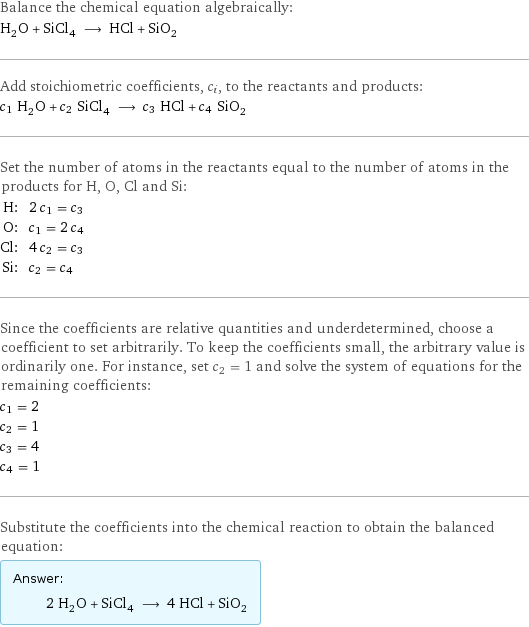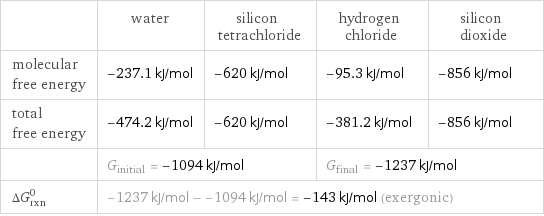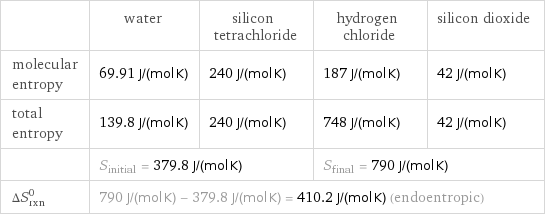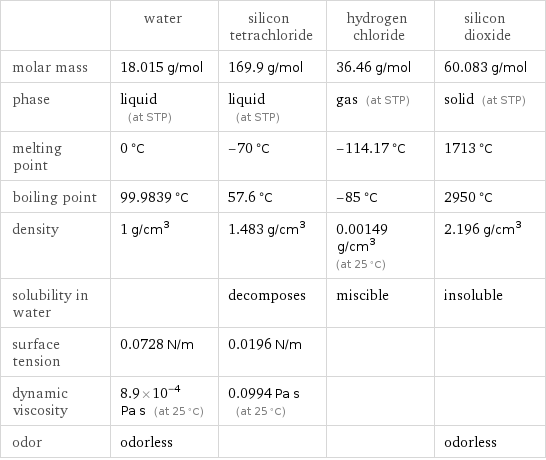Input interpretation

H_2O water + SiCl_4 silicon tetrachloride ⟶ HCl hydrogen chloride + SiO_2 silicon dioxide
Balanced equation

Balance the chemical equation algebraically: H_2O + SiCl_4 ⟶ HCl + SiO_2 Add stoichiometric coefficients, c_i, to the reactants and products: c_1 H_2O + c_2 SiCl_4 ⟶ c_3 HCl + c_4 SiO_2 Set the number of atoms in the reactants equal to the number of atoms in the products for H, O, Cl and Si: H: | 2 c_1 = c_3 O: | c_1 = 2 c_4 Cl: | 4 c_2 = c_3 Si: | c_2 = c_4 Since the coefficients are relative quantities and underdetermined, choose a coefficient to set arbitrarily. To keep the coefficients small, the arbitrary value is ordinarily one. For instance, set c_2 = 1 and solve the system of equations for the remaining coefficients: c_1 = 2 c_2 = 1 c_3 = 4 c_4 = 1 Substitute the coefficients into the chemical reaction to obtain the balanced equation: Answer: | | 2 H_2O + SiCl_4 ⟶ 4 HCl + SiO_2
Structures

+ ⟶ +
Names

water + silicon tetrachloride ⟶ hydrogen chloride + silicon dioxide
Reaction thermodynamics
Gibbs free energy

| water | silicon tetrachloride | hydrogen chloride | silicon dioxide molecular free energy | -237.1 kJ/mol | -620 kJ/mol | -95.3 kJ/mol | -856 kJ/mol total free energy | -474.2 kJ/mol | -620 kJ/mol | -381.2 kJ/mol | -856 kJ/mol | G_initial = -1094 kJ/mol | | G_final = -1237 kJ/mol | ΔG_rxn^0 | -1237 kJ/mol - -1094 kJ/mol = -143 kJ/mol (exergonic) | | |
Entropy

| water | silicon tetrachloride | hydrogen chloride | silicon dioxide molecular entropy | 69.91 J/(mol K) | 240 J/(mol K) | 187 J/(mol K) | 42 J/(mol K) total entropy | 139.8 J/(mol K) | 240 J/(mol K) | 748 J/(mol K) | 42 J/(mol K) | S_initial = 379.8 J/(mol K) | | S_final = 790 J/(mol K) | ΔS_rxn^0 | 790 J/(mol K) - 379.8 J/(mol K) = 410.2 J/(mol K) (endoentropic) | | |
Equilibrium constant
![K_c = ([HCl]^4 [SiO2])/([H2O]^2 [SiCl4])](../image_source/845dabfc9aade519d830ed0e7e865478.png)
K_c = ([HCl]^4 [SiO2])/([H2O]^2 [SiCl4])
Rate of reaction
![rate = -1/2 (Δ[H2O])/(Δt) = -(Δ[SiCl4])/(Δt) = 1/4 (Δ[HCl])/(Δt) = (Δ[SiO2])/(Δt) (assuming constant volume and no accumulation of intermediates or side products)](../image_source/1c4c5384e6898afda4d40d4b60a681e7.png)
rate = -1/2 (Δ[H2O])/(Δt) = -(Δ[SiCl4])/(Δt) = 1/4 (Δ[HCl])/(Δt) = (Δ[SiO2])/(Δt) (assuming constant volume and no accumulation of intermediates or side products)
Chemical names and formulas

| water | silicon tetrachloride | hydrogen chloride | silicon dioxide formula | H_2O | SiCl_4 | HCl | SiO_2 Hill formula | H_2O | Cl_4Si | ClH | O_2Si name | water | silicon tetrachloride | hydrogen chloride | silicon dioxide IUPAC name | water | tetrachlorosilane | hydrogen chloride | dioxosilane
Substance properties

| water | silicon tetrachloride | hydrogen chloride | silicon dioxide molar mass | 18.015 g/mol | 169.9 g/mol | 36.46 g/mol | 60.083 g/mol phase | liquid (at STP) | liquid (at STP) | gas (at STP) | solid (at STP) melting point | 0 °C | -70 °C | -114.17 °C | 1713 °C boiling point | 99.9839 °C | 57.6 °C | -85 °C | 2950 °C density | 1 g/cm^3 | 1.483 g/cm^3 | 0.00149 g/cm^3 (at 25 °C) | 2.196 g/cm^3 solubility in water | | decomposes | miscible | insoluble surface tension | 0.0728 N/m | 0.0196 N/m | | dynamic viscosity | 8.9×10^-4 Pa s (at 25 °C) | 0.0994 Pa s (at 25 °C) | | odor | odorless | | | odorless
Units
